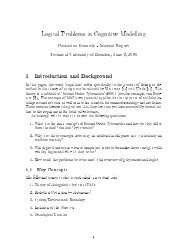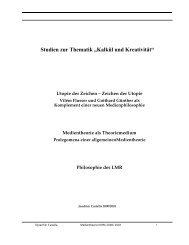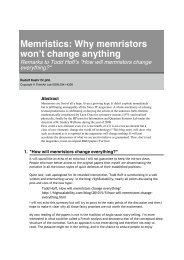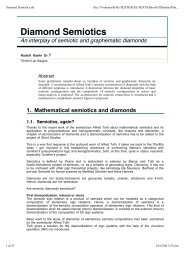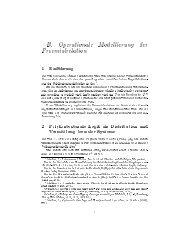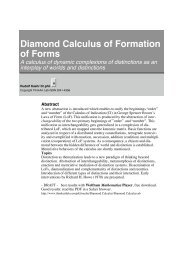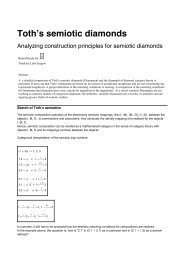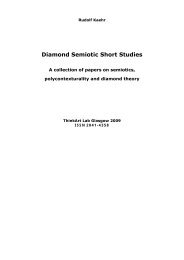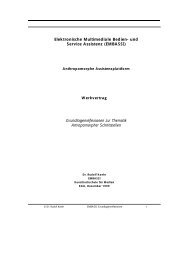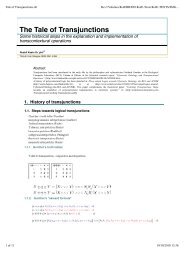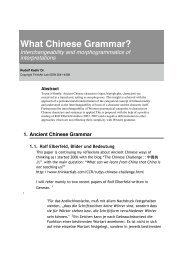Catching Transjunctions - ThinkArt Lab!
Catching Transjunctions - ThinkArt Lab!
Catching Transjunctions - ThinkArt Lab!
You also want an ePaper? Increase the reach of your titles
YUMPU automatically turns print PDFs into web optimized ePapers that Google loves.
<strong>Catching</strong> <strong>Transjunctions</strong>.nb<br />
file:///Volumes/KAEHR/HD-KAE-Texte/KAE-TEXTS/Publi...<br />
<strong>Catching</strong> <strong>Transjunctions</strong><br />
Steps towards an emulation of polycontextural transjunctions in<br />
memristic systems<br />
Rudolf Kaehr Dr. phil @<br />
<strong>ThinkArt</strong> <strong>Lab</strong> Glasgow ISSN 2041-4358<br />
Abstract<br />
How to understand Gunther’s idea of transjunctional operators And how to implement transjunctions in<br />
memristive systems<br />
1. Bifunctorial approach<br />
1.1. Distribution of junctions<br />
1 of 26 15/10/2010 19:01
<strong>Catching</strong> <strong>Transjunctions</strong>.nb<br />
file:///Volumes/KAEHR/HD-KAE-Texte/KAE-TEXTS/Publi...<br />
2 of 26 15/10/2010 19:01
<strong>Catching</strong> <strong>Transjunctions</strong>.nb<br />
file:///Volumes/KAEHR/HD-KAE-Texte/KAE-TEXTS/Publi...<br />
3 of 26 15/10/2010 19:01
<strong>Catching</strong> <strong>Transjunctions</strong>.nb<br />
file:///Volumes/KAEHR/HD-KAE-Texte/KAE-TEXTS/Publi...<br />
1.2. <strong>Transjunctions</strong><br />
4 of 26 15/10/2010 19:01
<strong>Catching</strong> <strong>Transjunctions</strong>.nb<br />
file:///Volumes/KAEHR/HD-KAE-Texte/KAE-TEXTS/Publi...<br />
5 of 26 15/10/2010 19:01
<strong>Catching</strong> <strong>Transjunctions</strong>.nb<br />
file:///Volumes/KAEHR/HD-KAE-Texte/KAE-TEXTS/Publi...<br />
1.3. Discussion of functorial formalization of transjunctions<br />
6 of 26 15/10/2010 19:01
<strong>Catching</strong> <strong>Transjunctions</strong>.nb<br />
file:///Volumes/KAEHR/HD-KAE-Texte/KAE-TEXTS/Publi...<br />
7 of 26 15/10/2010 19:01
<strong>Catching</strong> <strong>Transjunctions</strong>.nb<br />
file:///Volumes/KAEHR/HD-KAE-Texte/KAE-TEXTS/Publi...<br />
This approach doesn't imply that transjunctions are definable by junctions and negations only<br />
but that transjunctions are distributed and mediated over different logical loci and that at<br />
those loci junctional parts are placed.<br />
Hence, under the condition of discontexturality and the use of the discontextural operator<br />
“transposition” transjunctions are ‘junctionally’ constructible.<br />
Because memristive systems are able to emulate logical and arithmetical operations, a<br />
memristive transjunction or transjunctional memristive systems, i.e. memristive systems with<br />
transjunctional behaviors are constructible in the framework of presumed discontextural<br />
systems.<br />
Hence, the challenge is to construct discontextural fields of memristivity and to establish its<br />
specific operators.<br />
As for neurobiology, cognitive actions are not determined by isolated synapses only but by<br />
assemblies of neural activities. It is not a big departure form the tradition to postulate that<br />
assemblies are distinguishable what means that they are different. Hence, the whole system to<br />
8 of 26 15/10/2010 19:01
<strong>Catching</strong> <strong>Transjunctions</strong>.nb<br />
file:///Volumes/KAEHR/HD-KAE-Texte/KAE-TEXTS/Publi...<br />
work needs interactions between different neural assemblies. Interactions between neural<br />
assemblies are of a different kind, at least in their functionality, than the operators insid<br />
assemblies, which have to be “bridged” by interactions. Hence, interactions are different to<br />
the intra-systemic operations, i.e. logical operators, like conjunction or disjunction and<br />
negation. It might be reasonable to opt for polycontextural transjunctions to deal with the<br />
interactions between assemblies of neural activity.<br />
Memristivity is a general property of nano-physical systems and occurs in different forms.<br />
Even nano-electronic memristivity is definable under different conditions. All those differences<br />
between memristive systems might be used to define discontextural conditions for the<br />
realization of memristive transjunctions.<br />
The technical equivalent for the set of logical signatures {True, False} are the couple {On, Off}.<br />
In an earlier paper I postulated the concept of poly-layered crossbar systems as polycontextural<br />
opposites of mono-layered, i.e. multi-layered crossbar systems of mono-contextural memristic<br />
systems.<br />
The double functionality, typical for memristors, is necessary and sufficient to construct<br />
mediation between discontextural domains.<br />
This idea of a construction is not properly working without memristors. If transjunctional<br />
behavior gets modeled with CMOS devices and NOR or NAND logic, the crucial difference<br />
between domains is not realizable because all subsystems belong to the same systematic locus,<br />
i.e. all are defined by the very same kind of logical values and physically by the same electronic<br />
conditions.<br />
The principle of localization of memristive operations is of crucial importance.<br />
Where enters the crucial feature of memrsitors, its retrograde recursiveness, into the<br />
mechanism of mediation<br />
Retro-gradeness was analyzed as a chiastic structure which occurs in the process of continuation<br />
(concatenation, prolongation) of morphograms. Obviously, the mediation of logical functions,<br />
like in (AND, AND, AND), is a case of chaining (composing) functions and morphograms.<br />
Mediation of AND might category-theoretically be modeled by cod(AND 1<br />
)= dom(AND 2<br />
),<br />
with the commuting morphism (AND 3<br />
)and the properties dom(AND 1<br />
)= dom(AND 3<br />
)and cod(AND 2<br />
)=<br />
cod(AND 3<br />
) and the presumption of a single universe of objects and morphisms.<br />
But this construction gets a chiastic interpretation and formalization in a polycontextural<br />
setting with diffferent, i.e. discontextural universes and morphisms.<br />
Chiasms are retro-grade constructions working as an interplay of ‘memory'- and ‘computing'-<br />
functions of memristors in different roles.<br />
Example of some combinations of mediation of junctors<br />
9 of 26 15/10/2010 19:01
<strong>Catching</strong> <strong>Transjunctions</strong>.nb<br />
file:///Volumes/KAEHR/HD-KAE-Texte/KAE-TEXTS/Publi...<br />
Each logical AND is emulated by memristive devices, memristors only or mixed with other<br />
mem-capacitators, mem-inductors, as Di Ventra et al defined and simulated it. Such memristive<br />
constructions are not yet focused on the time- and history dependence of the used memristors.<br />
A new use of memristors enters the theater whith the interactions between memristors of<br />
different domains. This mechanism of connecting different domains happens in the mode of<br />
chiasms which are defined by their retro-grade properties.<br />
Hence, memrisor-based logical junctions are mediated by memristive elements exploiting their<br />
memristive features of retro-gradeness. Hence, the focus on the roles of memristors are<br />
different, on a first-level interpretation, memristors are defining junctors without any<br />
involvement in retro-gradeness. On a second-order level, the memristive property of retrogradeness<br />
o the behavior of memristors is in the focus and utilized for the mediation of<br />
memristive structures of different loci (domains).<br />
2. Modeling and emulating logical operators<br />
2.1. Modeling and emulating material implication<br />
Lehtonen’s example for the emulation of material implication with two memristors and 1<br />
resistor only.<br />
2.2. Memristive modeling and emulating of logical functions<br />
2.2.1. Di Ventraʼs physical model<br />
10 of 26 15/10/2010 19:01
<strong>Catching</strong> <strong>Transjunctions</strong>.nb<br />
file:///Volumes/KAEHR/HD-KAE-Texte/KAE-TEXTS/Publi...<br />
"Fig. 6. (Color online) Electronic circuit for Boolean logic and arithmetic operations.<br />
In this circuit, an array of N memristors M , memcapacitor C and resistor R are connected to a<br />
common (horizontal) line. The circuit operation involves charging the memcapacitor C through<br />
input memristors and discharging it through the output ones.<br />
Because of the circuit symmetry, each memristor can be used as input or output.<br />
From the opposite (top) side, memristors are driven by 3-state (0V, V , not connected) drivers.<br />
The right 4-state (0V, V /2, V , not connected) driver DR connected through a resistor to the<br />
common line is used to initialize memristors and memcapacitor. This scheme employs<br />
threshold-type bipolar memristors assuming that the application of positive voltage to the top<br />
memristor electrode and 0V to the bottom electrode switches memristor from low resistance<br />
state (1 or ON) to the high resistance state (0 or OFF). It is also assumed that the memristors’<br />
threshold voltage V is between V /2 and V .” (Di Ventra)<br />
Memristive simulation of the logical junctors AND, OR, NOT<br />
"Fig. 7. (Color online) Experimental realization of the basic logic gates with memristors based<br />
on the circuit shown in Fig. 6 with a capacitor C = 10µF instead of a memcapacitor.<br />
In our experimental circuit, the role of memristors is played by memristor emulators [...]<br />
governed by the threshold type model of Eqs. (3) and (4) with the following set of parameters:<br />
V = 4V, α = 0, β = 62MOhms/(V·s).<br />
Each plot shows several measurements of the voltage between the top plate of the capacitor<br />
(the common line defined in the caption of Fig. 6) and ground taken for different possible<br />
11 of 26 15/10/2010 19:01
<strong>Catching</strong> <strong>Transjunctions</strong>.nb<br />
file:///Volumes/KAEHR/HD-KAE-Texte/KAE-TEXTS/Publi...<br />
states of input memristors.<br />
In (a) we also show an example of voltages applied to the drivers to generate the top voltage<br />
plot. The voltages on the drivers in (a) are in absolute values while the other curves were<br />
vertically displaced for clarity.”<br />
Yuriy V. Pershin and Massimiliano Di Ventra, Neuromorphic, Digital and Quantum Computation<br />
with Memory Circuit Elements<br />
The simulation runs with 3 memristors, 1 memcapacitor and 1 resistor. If two memristors are<br />
enough to simulate logical function, a distribution of logical functions over 3 contextures needs<br />
therefore not more than 9 memristors. But with 9 memristors only separated and not mediated<br />
logical functions could be simulated in their specific domain. Additionally to the definition and<br />
realization of 3 different domains, which will be represented by different voltage-domains, at<br />
least 3x2 additional memristors are demanded to realize the mediation (connection) between<br />
the 3x3 distributed memristors.<br />
2.2.2. Mediation of memristors<br />
Types of combinations of memristors<br />
Classical combinations: serial and parallel,<br />
Transclassical combinations: mediations, i.e. interactional, reflectional and interventional<br />
mediations.<br />
How are mediator defined<br />
In more abstract terms, mediators are realizing the matching conditions for the composition of<br />
morphisms (functions, operations).<br />
MEM are memristors with an intra-contextural selective switch-function, basic for the<br />
emulation of logical and arithmetical operations. In contrast, the role of memristor MEM is an 3<br />
elective trans-contextural function, realizing the functor ‘mediation' ( ).<br />
funct(MEM) = (election, selection)<br />
selection = [ON/OFF] for digital and [ON,..., OFF] for analog operations in a<br />
contexture,<br />
election = switch of contextures in the mode of transpositions, reflections and<br />
interventions.<br />
Selection is realized by the first-order functionality of memristors in a crossbar system,<br />
Election is realized by the second-order functionality of memristors between different crossbar<br />
systems.<br />
First-order states of a memristive configuration are defining the type of primary action, i.e.<br />
logical junctions and basic arithmetic operations.<br />
Second-order states of a memristive configuration are states of states, memorizing the<br />
first-order states of precessing states and as a new functionality, the context of those first-order<br />
states. Because states are always realized in a context, the memorization function of the state<br />
of the state delivers both, the former first-order state and its context (contexture).<br />
"Because of the graphematical tabularity of ConTextures there are not only two possibilities to<br />
perform a selection. For each contexture there are intra-contexturally only two possibilities to<br />
perform a selection. But between contextures, transcontexturally, there are as many new<br />
selectors as neighbor contextures. These new "selectors" should be called electors. Electors are<br />
12 of 26 15/10/2010 19:01
<strong>Catching</strong> <strong>Transjunctions</strong>.nb<br />
file:///Volumes/KAEHR/HD-KAE-Texte/KAE-TEXTS/Publi...<br />
electing the election for selectors to perform mutually each its selection.<br />
In other words, such a general a selector as any other successive or procedural the same<br />
contexture or trans-conA selector as a complexion can be realized at once in different<br />
contextures. It could therefore be called a "poly-selector". Such a poly-selector can be defined<br />
as an overlapping of an intra-contextural selector "sel" and a trans-contextural selector, called<br />
elector ‘elect'." (ConTeXtures, p. 20, 2005)<br />
A prolongation of such a tupel of (state, context) is a double-function, realized by ‘selection’<br />
and ‘election’.<br />
Hence, a further logical or arithmetical step always has first to select the context, i.e. to chose<br />
to stay in the actual context or to chose another context for prolongation. Both at once might<br />
happen too, to change and to stay in context. After this contextural decision (election), the<br />
well known logical and arithmetical operations might continue by selection.<br />
2.3. Dissemination<br />
2.3.1. Superoperators in action<br />
Boiled down to the simplest structure avaible the whole game of dissemination (monoidal)<br />
categories and memristive crossbar systems too, is to introduce an additional operator to the<br />
known operators, i.e composition and yuxtaposition.<br />
This operator, called disseminatior, consisting of the two compelemtary aspects “distribution”<br />
and “mediation”, is abstracting the whole box of the theory of monoidal categories as a new<br />
unit and is distributing it with the operator of “election” over a kenomic matrix.<br />
A specification of the distribution operator is given by the so called “super-operators”:<br />
id: identity<br />
perm: permutation,<br />
red: reduction,<br />
repl: replication,<br />
bif: bifurcation.<br />
13 of 26 15/10/2010 19:01
<strong>Catching</strong> <strong>Transjunctions</strong>.nb<br />
file:///Volumes/KAEHR/HD-KAE-Texte/KAE-TEXTS/Publi...<br />
14 of 26 15/10/2010 19:01
<strong>Catching</strong> <strong>Transjunctions</strong>.nb<br />
file:///Volumes/KAEHR/HD-KAE-Texte/KAE-TEXTS/Publi...<br />
2.4. Distribution of conjunction<br />
=<br />
1. :<br />
conceptual mediation ( ) of the distributed implications .<br />
2. ( :<br />
conceptual mediation of conjunction and realization of conjunction<br />
contexture.<br />
R<br />
is omitted.<br />
by two memristors per<br />
3.<br />
realization of conjunction AND and mediation by two memristors per contexture and<br />
one memristive processor between contextures (procm).<br />
More concretely, the interaction of AND and AND is ruled by the operator of mediation<br />
“ which is the ‘diagonal’ mediation “ ” of the planar kenomic matrix.<br />
This together constitutes a memristive system of distributed and mediated memristors in their<br />
double role as memory for the realization of the conjunction AND and in the role as processors<br />
for the mediation “ ” of the contextures of the distributed conjunctions.<br />
The same wording holds for the distribution of disjunction OR.<br />
Because of the lacalization of operators in memristic systems not all operators are placed on the<br />
“diagonal” of the kenomic matrix. For a distribution and mediation of implication further<br />
operators, like replication have to be applied.<br />
Coincidence relation<br />
For a coincidence relation between v(ON ) and v(ON ) holds.<br />
1 3<br />
Also V 1 and V 3 are disjunct, V 1 ∩ V = ∅, they coincede at v(ON 1<br />
) ≡ v(ON 3<br />
) and at OFF 2.3<br />
with<br />
v(OFF 2<br />
) ≡ v(OFF 3<br />
).<br />
Because ON 1<br />
and ON 3<br />
are mediated by the operator<br />
, which is realized by a processing<br />
memristor, there is no logical or electronic contradiction or conflict involved in this mediating<br />
mechanism. The same holds for OFF 2<br />
and OFF 3<br />
.<br />
This is nothig mysterious. For the classical case, a logical interpretation of the physical values<br />
happens too. In many respects, electronics and computer hardware is a question of<br />
interpretation, i.e. hemeneutics, and not of naked physics.<br />
"In this type of application, each memristor is used in the “digital” mode of operation, namely<br />
only one bit of information is encoded in the memristor’s state. We call “1” (ON) the state of<br />
lower resistance and “0” (OFF) that of higher resistance. The operation of the circuit sketched<br />
in Fig. 6 relies on charging a memcapacitor through input memristors and subsequent<br />
discharging through the output ones.” (Di Ventra)<br />
What’s definitively new and not yet tested is the mix of the voltage intepretation with the new<br />
domain interpretation.<br />
15 of 26 15/10/2010 19:01
<strong>Catching</strong> <strong>Transjunctions</strong>.nb<br />
file:///Volumes/KAEHR/HD-KAE-Texte/KAE-TEXTS/Publi...<br />
Again, a value in a disconctxtural system is always a value of a contexture (domain), hence it<br />
has a double characteristics, one for the internal physical value (voltage) and one for the<br />
domain it belongs, i.e. its place-value marked by the place-designator.<br />
Hence, “0” as “OFF” and “1” as “ON” has to be specified, i.e. indexed by its domain<br />
(contexture).<br />
For distributed conjunction (AND AND AND)we get: ((AND<br />
AND) AND)<br />
1.2<br />
Again, there might be some obstacles. The interpretation ON 1 ≅ ON 3 and OFF 2 ≅ OFF 3 might<br />
have some plausibility. It seems to be more difficult to accept the interpretation: OFF 1 ≅ ON 2 .<br />
But that’s not much more than the matching conditions between contexture1 and contexture2,<br />
with<br />
cod(contexture1) ≅ dom(contexture2).<br />
2.5. Formal modeling<br />
A simplified categorical formulation for distributed memristors and implications based on<br />
memristors is shown with the following two formulas.<br />
If we accept this categorical construction for AND and OR for experimental reasons we might<br />
continue with the more intriguing situation of interactions between contextures ruled by<br />
transjunctions.<br />
On the base of the proposed sketches, here and in the paper “Poly-layered crossbars”, an<br />
implementation of transjunctions on the base of memristive devices in the framework of<br />
discontexturality shouldn’t be an impossible task.<br />
Hence the logical interpretation of transjunctions in cooperation with conjunctions, as studied<br />
16 of 26 15/10/2010 19:01
<strong>Catching</strong> <strong>Transjunctions</strong>.nb<br />
file:///Volumes/KAEHR/HD-KAE-Texte/KAE-TEXTS/Publi...<br />
before, are easily transposed into an electronic setting.<br />
Trivially, True is ON, False is OFF<br />
2.5.1. Interchangeability for (<br />
CASE for OFF<br />
OFF 1<br />
X et OFF 1<br />
Y<br />
2.5.2. Memristic emulation of transjunction and junctions<br />
17 of 26 15/10/2010 19:01
<strong>Catching</strong> <strong>Transjunctions</strong>.nb<br />
file:///Volumes/KAEHR/HD-KAE-Texte/KAE-TEXTS/Publi...<br />
18 of 26 15/10/2010 19:01
<strong>Catching</strong> <strong>Transjunctions</strong>.nb<br />
file:///Volumes/KAEHR/HD-KAE-Texte/KAE-TEXTS/Publi...<br />
19 of 26 15/10/2010 19:01
<strong>Catching</strong> <strong>Transjunctions</strong>.nb<br />
file:///Volumes/KAEHR/HD-KAE-Texte/KAE-TEXTS/Publi...<br />
2.6. Formal modeling negation<br />
Negation is a fundamental operator for logic, and therefore for memristive implementations<br />
too.<br />
From a formal point of view both aspects have to be considered, the permutation and the<br />
mediation of negators in a mediated complexion.<br />
;<br />
Monoidal permutation: A 1<br />
.<br />
2.6.1. Speculative emulation for negations<br />
20 of 26 15/10/2010 19:01
<strong>Catching</strong> <strong>Transjunctions</strong>.nb<br />
file:///Volumes/KAEHR/HD-KAE-Texte/KAE-TEXTS/Publi...<br />
2.7. Speculative emulation for (AND AND AND)<br />
21 of 26 15/10/2010 19:01
<strong>Catching</strong> <strong>Transjunctions</strong>.nb<br />
file:///Volumes/KAEHR/HD-KAE-Texte/KAE-TEXTS/Publi...<br />
2.7.1. Speculative modeling of transjunctions<br />
3. Morphogrammatics of transjunctions<br />
3.1. Morphic abstraction of<br />
22 of 26 15/10/2010 19:01
<strong>Catching</strong> <strong>Transjunctions</strong>.nb<br />
file:///Volumes/KAEHR/HD-KAE-Texte/KAE-TEXTS/Publi...<br />
The Abacus of Universal Logics<br />
23 of 26 15/10/2010 19:01
<strong>Catching</strong> <strong>Transjunctions</strong>.nb<br />
file:///Volumes/KAEHR/HD-KAE-Texte/KAE-TEXTS/Publi...<br />
http://works.bepress.com/thinkartlab/17/<br />
3.2. General schemes for transjunctions and reflectors<br />
3.2.1. Transjunction schemes<br />
Transjunction scheme for :<br />
24 of 26 15/10/2010 19:01
<strong>Catching</strong> <strong>Transjunctions</strong>.nb<br />
file:///Volumes/KAEHR/HD-KAE-Texte/KAE-TEXTS/Publi...<br />
3.2.2. Reflector<br />
25 of 26 15/10/2010 19:01
<strong>Catching</strong> <strong>Transjunctions</strong>.nb<br />
file:///Volumes/KAEHR/HD-KAE-Texte/KAE-TEXTS/Publi...<br />
26 of 26 15/10/2010 19:01



